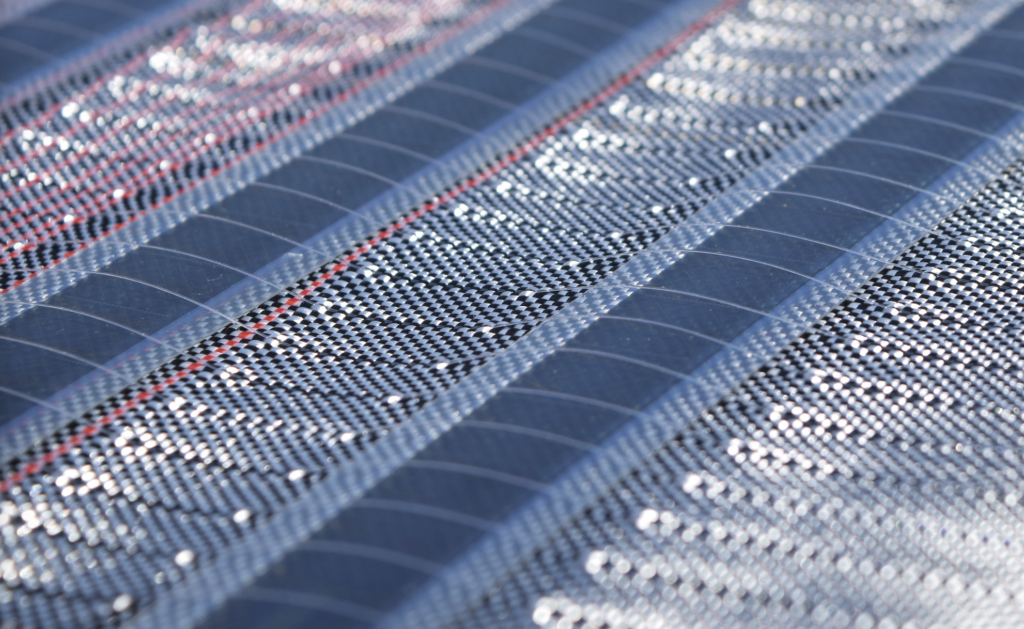Solar power has long been touted as a key solution to reducing carbon emissions and mitigating climate change. But traditional solar panels can be heavy and inflexible, making them unsuitable for certain applications. Enter SUNTEX, an e-textile developed by Studio Pauline van Dongen in collaboration with Tentech.
The Evolution of Studio Pauline van Dongen’s Work
The idea for SUNTEX arose from Pauline van Dongen‘s longstanding work with solar technology and smart clothes. She has created solar clothing pieces in the past, such as the Solar Dress in 2013 and the Solar Shirt in 2016, and has been exploring the possibilities of e-textiles and smart textiles.
However, the evolution of solar technology in recent years, particularly the availability of highly flexible thin-film organic photovoltaic panels (OPVs), led her to explore new possibilities.
Versatility in Textile and Architectural Design
SUNTEX is woven with these OPVs, which are capable of turning sunlight into energy. Connective tracks link the panels, which can then be connected to a battery. This innovative e-textile can be used in architectural applications, such as facades and shading structures, as well as wearable applications, like solar backpacks and jackets.
One of the unique benefits of SUNTEX is its ability to be used on surfaces that would otherwise be untapped by traditional solar panels, such as tents and shelters. The lightweight and flexible nature of the smart textile also allows it to be used in textile architecture and as a second skin for buildings, improving their thermal qualities while simultaneously generating energy.
Regarding energy efficiency, the output of SUNTEX can vary depending on the number of panels integrated into the textile. With the current technology, an expected output of 20w/m² can be achieved with a 50/50 panel-to-textile ratio. However, the developers hope to incorporate soon higher-efficiency panels that can deliver 70w/m².


SUNTEX’s Sustainable and Recyclable Design
Sustainability was a key consideration in the development of SUNTEX. Recycled PET is used as the main yarn for fabric construction, and the textile is kept recyclable and repairable by avoiding overall coating with materials like PVC. Additionally, the OPV technology used in SUNTEX has one of the lowest environmental footprints of all solar technologies on the market.
Collaboration with Tentech was instrumental in the development of SUNTEX. Their expertise in structural engineering and textile requirements helped to create strategies and plans for practical applications of smart clothes. The modular concept of SUNTEX also allows for easy separation of the solar technology from the base textile, allowing for separate recycling and reducing the environmental impact of disposal.
The next step for E-Textiles
Looking to the future, the developers of SUNTEX envision a wide range of applications for e-textiles and smart textiles. The technology could reupholster existing buildings, making them more energy-efficient. It could also be incorporated into public spaces like park benches and bus stops to generate energy. The evolution of OPV technology is also expected to lead to more efficient versions of SUNTEX in the future.
The response to SUNTEX has been overwhelmingly positive, with interest from both the design and architecture communities as well as the tech scene. As Studio Pauline van Dongen’s approach to innovation and experimentation is deeply collaborative and cross-disciplinary, the development of SUNTEX fits perfectly within their overall design philosophy of creating sustainable and functional e-textiles and smart textiles.
In terms of sustainable energy and design practices, SUNTEX is a valuable addition to the energy transition. By generating solar energy on the previously untapped surface area, it helps move towards a cleaner and more sustainable future, especially in e-textiles, smart clothes, and smart textiles.



